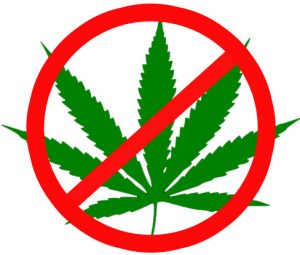In the Rolling Stones’ hit song “You Can’t Always Get What You Want,” the lyrics lament You can’t always get what you want/But if you try sometime you find/You get what you need. Right now, what the United States needs is a more coherent, rational, and comprehensive approach to the legalization and regulation of marijuana. Failure to do so will only foster continued growth in illegal marijuana production and sales.

The Current State of Illegal Marijuana
Currently, all but a handful of states have made marijuana consumption either recreationally or medically legal, and many have decriminalized possession for small amounts. All of this has opened access to millions of consumers who previously bought marijuana through illegal channels. An yet, the illegal marijuana business, far from slipping into obsolescence, is apparently thriving.
According to WBUR, Boston’s NPR news station, the “widespread side effect of marijuana legalization in the U.S” has in many cases”…fueled, rather than eliminated, the black market.”
For example, in Los Angeles, WBUR reports that “unlicensed businesses greatly outnumber legal ones.” The same is true for Nevada, where according to the newspaper Nevada Current, “Nevada continues to maintain a large number of unlicensed retailers, competing against legal dispensaries and denying the state and local government of tax dollars…”
California is even worse. Despite the fact that the Golden State was one of the first states to make marijuana medically legal, and made it recreationally legal in 2016, the illegal market there is booming. As reported recently in USA Today, “More than 42,000 illegal marijuana plants [were] discovered recently on California public lands [and] have been eradicated.” And the Los Angeles Times reports that the “…black market for marijuana continues to flourish. . .” Ditto for Maine, where”… high prices and a lack of supply are driving many Maine cannabis consumers back to the streets.”
So, what gives? Why does a significant proportion of the population purchase illegal marijuana when safer, legal alternatives are available? The answer is somewhat complex, and includes factors such as price, regulatory hurdles, inconsistent legislative frameworks, market situation, and transnational black markets, all of which are interconnected and interdependent.
Taxation and Regulation: A Boon to Illegal Marijuana
Beyond the recreational and medical applications of marijuana, weed is above all, a market. As such, it is subject to the traditional market forces of supply and demand, and associated conditions such as policy and taxation that drive prices of legal cannabis up.
Massachusetts-based cannabis advocate Maggie Kinsella points out that “. . . the illicit markets thriving in parts of California and Massachusetts are self-inflicted wounds” owing to “[H]igh state taxes and fees” . . .” that drive “… up the price of legal cannabis, and mild repercussions for remaining unlicensed discourage existing business owners from navigating the complex licensing process in both Los Angeles and Boston.”
This combination of high taxation in conjunction with fees associated with regulatory hurdles associated with licensing put legal cannabis dispensaries at a competitive disadvantage with illegal operations. Dan Nosowitz, writing for modernfarmer.com, warns that “ . . those taxes, in addition to the standard cost of regular businesses (labor, rent, that kind of thing), mean that legal marijuana is typically significantly more expensive than illegal. And unlike with many disrupted industries, the illegal marijuana industry was already generally pretty convenient, operated through texting and delivery.”
Again, and perhaps ironically, California is a primary culprit in the elevation of the illegal cannabis market. The LA Times states it bluntly: “Many cannabis growers, retailers and manufacturers have struggled to make the transition from a provisional, temporary license to a permanent one renewed on an annual basis — a process that requires a costly, complicated, and time-consuming review of the negative environmental effects involved in a business and a plan for reducing those harms.” Nosowitz concurs, stating, “ One of the biggest issues for legal marijuana businesses appears to be a copious helping of red tape. California has a complex, expensive, multi-step and mandatory environmental review process for marijuana growers, under the California Environmental Quality Act (CEQA).”
Part of the problem is the lack of coherency of regulations between the state and municipal levels. Although some states have cleared legal language and guidance documents, in “. . . states like California and Colorado, statewide legalization looks more like Swiss cheese rather than a unified decision passed by voters” states the blog Cannabis Industry, adding, “In California, close to 80% of the 482 municipalities in the state have banned commercial marijuana activity.”
Some 3,000 miles away in the state of Massachusetts, similar problems plague the Bay State. Steve Hoffman of the Massachusetts Cannabis Commission makes it plain “…that the illicit market in Massachusetts likely won’t die until cannabis is fully legalized federally and access to things like banking—for basic needs such as loans and deposits—is easier for startup marijuana businesses. The barriers to entry, he says, are still high and discourage even those who have had approved licenses from opening up shop.”

Michigan faces similar issues, with a thriving illegal marijuana market undercutting profitability in the legal sector. As the Politico article The pandemic is eating away at the illicit marijuana market reports, “Michigan faces a similar problem in quashing illegal sales: The vast majority of cities in the state — including Detroit — still don’t allow recreational pot shops to operate.
These barriers are pervasive and have a direct connection to the illegal marijuana market. Casey O’Neill, a longtime Mendocino County cannabis farmer and a board member of the California Growers Association trade group, elegantly captures this dynamic in a report by Portland State University, stating: “There are thousands of people who would love to participate in the regulated market who are totally locked out… people are stuck choosing between their ethics and the need to feed their families. Those people have definitely propped up the unregulated market.”
These discrepancies ultimately mean that not only are current dispensaries unable to compete with the illegal market, but there is a built-in disincentive for establishing new dispensaries. The bottom line is this causes a lack of legal supply, giving more opportunities for illegal marijuana activity.
Illegal Marijuana and the Federal Government
As I stated in the introduction of this article, all of these factors are interconnected. And if you peel back the onion to its core, you find the bulb can be traced back to the federal level. Stephen Siff, assistant professor at Miami University of Ohio in the Department of Media, Journalism, and Film, frames it this way: “Consider that marijuana remains on the federal government’s list of Schedule I drugs, defined as the most dangerous of the controlled substances. . .”
This inconsistency between federal marijuana law and state marijuana laws creates loopholes for illegal activity. “You’re never going to eliminate [the illicit market] until most of the states are legal,” says Adam Smith of the Craft Cannabis Alliance, a group in Oregon that advocates for small cannabis farmers. “As long as half the country still can’t get it legally, there’s a market for it illegally.”
Most of this dynamic is created when legal marijuana from one state is shipped to other states where it is illegal, or not as readily available. A prime example would be Oregon, which has fully and liberally legalized recreational marijuana consumption, such to the point there is a glut of cannabis products. Meanwhile, in Idaho, just to the east of the Beaver State, marijuana is completely illegal, creating a raging demand for black market marijuana. Natalie Fertig, a writer in Washington, D.C. covering cannabis and politics writes, this inconsistency has “. . .pushed illegal growers to export their goods across borders into other states where it’s still illegal, leaving law enforcement overwhelmed.”
This is not merely an academic or economic issue, but actually goes right to the heart of the idea that the federal government may have overstepped its role in the regulation of marijuana. As the conservative Justice Clarence Thomas, stated: “By holding that Congress may regulate activity that is neither interstate nor commerce under the Interstate Commerce Clause, the Court abandons any attempt to enforce the Constitution’s limits on federal power.”
The Market Situation and Illegal Marijuana
Another contributing factor is market situation, which is “those aspects of the position of an individual or group within social stratification which are determined by market forces.” In other words, market situation is how individual consumers behave within the larger social context in which they live. One example of this is for people who are in the United States illegally but are also marijuana users. According to the Immigrant Legal Resource Center, “Admitting to having possessed marijuana can disqualify an applicant for cancellation of removal, cause any non-citizen, including a permanent resident, to be excluded at the border; and destroy eligibility for family immigration.”
Such fears will undoubtedly drive this group of people to resort to illegal means of procurement. This is not necessarily an argument on my part to not have immigration enforcement, but to act more rationally in light of market situation. And, with approximately 12 million people in the United States illegally, this is not a trivial matter. If marijuana was broadly available on a national level and completely legal, immigrants, many of whom desire citizenship, would have less to fear, and would opt for legal routes for marijuana purchases. The bottom line is we need to disentangle the legal status of marijuana from the legal status of immigrants or risk bolstering the illegal marijuana market.
Illegal Marijuana and Transnational Crime
Making matters worse is the fact that law enforcement cannot keep up with transnational black market operations. Filling the void between supply and demand are international gangs. As the authors Dennis Romero, Gabe Gutierrez, Andrew Blankstein, and Robert Powell state in an NBC News article, “Federal officials allege that legal recreational marijuana states like California, Colorado, and Washington, where enforcement of growing regulations is hit-or-miss, have been providing cover for transnational criminal organizations willing to invest big money to buy or rent property to achieve even bigger returns.”
And the deeper you dig, the uglier the truth you uncover. As a means to keep their operations flowing, these syndicates rely on human capital made available through smuggling schemes. Romero et al. reveal that “Chinese, Cuban and Mexican drug rings have purchased or rented hundreds of homes and use human trafficking to bring inexperienced growers to the United States to tend them. . .”
The investigative reporter Sara Carter echoes this bleak picture: “They are not afraid of hiding it, they don’t hide it because they don’t feel they will ever be held accountable for it and they continue to sell their product – not only across the United States, but according to law enforcement, they are moving millions of dollars, if not billions, overseas, and we don’t even know where that’s going.”
It’s beyond the scope of this article to deal with this transnational element. However, rather than focusing on this juggernaut, it would seem logical that the best approach is to increase the legal supply by reducing taxation, regulatory barriers, and access to a safe, rationally regulated supply. John Hudak, deputy director of the Center for Effective Public Management and a senior fellow in Governance Studies at the Brookings Institute puts it this way: “Cannabis consumers are rational economic actors. They’re probably going to pick the cheaper option. In a lot of states, that would mean black market cannabis.”
But if we reduce all of these impediments, the legal supply will increase, and it’s likely most people will prefer to procure marijuana through legal channels.
And despite the presence of the illegal marijuana market, most consumer trends point in this direction. Mitch Baruchowitz, managing partner at cannabis investment firm Merida Capital Partners argues that “The vast majority of the current growth in the cannabis space is being driven by consumers transitioning from the black market to the legal market.”
Our task then is to support and accelerate this trend, thereby reducing the footprint of organized crime. This is a more sober and realistic approach, given the strength of the illegal competition. As Hoffman asserts, “I don’t think we’re ever completely going to eliminate the illicit market, I think that’s probably unrealistic.”
Meanwhile, change is slow at the federal level. And though legalization is a pressing issue, as the Rolling Stones song says, “Time is on our side.”
Yes, it is.
At Newsweed.com, we adhere to three simple principles: truth, balance, and relatability. Our articles, podcasts, and videos strive to present content in an accurate, fair, yet compelling and timely manner. We avoid pushing personal or ideological agendas because our only agenda is creating quality content for our audience, whom we are here to serve. That is why our motto is ”Rolling with the times, straining for the truth.”
Your opinion matters. Please share your thoughts in our survey so that Newsweed can better serve you.
Charles Bukowski, the Los Angeles beat poet that captured the depravity of American urban life once said, “There is something about writing poetry that brings a man close to the cliff’s edge.” Newsweed is proud to stand in solidarity and offer you a chance to get close to the cliff’s edge with our first Power of Poetry Contest.
Are you a budding bard, a versatile versifier, a rhyming regaler? Do you march to the beat of iambic pentameter, or flow like a river with free verse? If so, here’s your opportunity to put your mad poetic chops to the test. Enter our poetry contest for bragging rights and an opportunity to win some cash!






